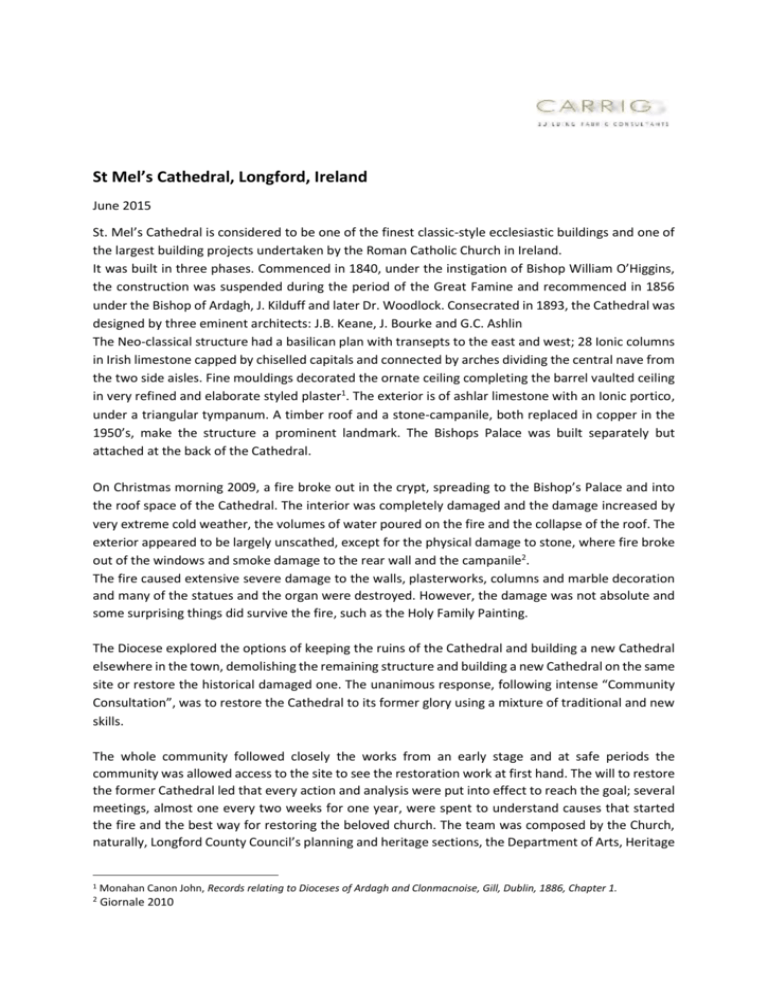St. Mels Cathedral, Longford
advertisement

St Mel’s Cathedral, Longford, Ireland June 2015 St. Mel’s Cathedral is considered to be one of the finest classic-style ecclesiastic buildings and one of the largest building projects undertaken by the Roman Catholic Church in Ireland. It was built in three phases. Commenced in 1840, under the instigation of Bishop William O’Higgins, the construction was suspended during the period of the Great Famine and recommenced in 1856 under the Bishop of Ardagh, J. Kilduff and later Dr. Woodlock. Consecrated in 1893, the Cathedral was designed by three eminent architects: J.B. Keane, J. Bourke and G.C. Ashlin The Neo-classical structure had a basilican plan with transepts to the east and west; 28 Ionic columns in Irish limestone capped by chiselled capitals and connected by arches dividing the central nave from the two side aisles. Fine mouldings decorated the ornate ceiling completing the barrel vaulted ceiling in very refined and elaborate styled plaster1. The exterior is of ashlar limestone with an Ionic portico, under a triangular tympanum. A timber roof and a stone-campanile, both replaced in copper in the 1950’s, make the structure a prominent landmark. The Bishops Palace was built separately but attached at the back of the Cathedral. On Christmas morning 2009, a fire broke out in the crypt, spreading to the Bishop’s Palace and into the roof space of the Cathedral. The interior was completely damaged and the damage increased by very extreme cold weather, the volumes of water poured on the fire and the collapse of the roof. The exterior appeared to be largely unscathed, except for the physical damage to stone, where fire broke out of the windows and smoke damage to the rear wall and the campanile2. The fire caused extensive severe damage to the walls, plasterworks, columns and marble decoration and many of the statues and the organ were destroyed. However, the damage was not absolute and some surprising things did survive the fire, such as the Holy Family Painting. The Diocese explored the options of keeping the ruins of the Cathedral and building a new Cathedral elsewhere in the town, demolishing the remaining structure and building a new Cathedral on the same site or restore the historical damaged one. The unanimous response, following intense “Community Consultation”, was to restore the Cathedral to its former glory using a mixture of traditional and new skills. The whole community followed closely the works from an early stage and at safe periods the community was allowed access to the site to see the restoration work at first hand. The will to restore the former Cathedral led that every action and analysis were put into effect to reach the goal; several meetings, almost one every two weeks for one year, were spent to understand causes that started the fire and the best way for restoring the beloved church. The team was composed by the Church, naturally, Longford County Council’s planning and heritage sections, the Department of Arts, Heritage 1 Monahan Canon John, Records relating to Dioceses of Ardagh and Clonmacnoise, Gill, Dublin, 1886, Chapter 1. 2 Giornale 2010 and Gaeltacht’s built heritage section and, of course the congregation. Dialogue with the local people forms part of the discernment around the future layout of the cathedral.3 In the following months during the recording, research and physical investigations of the damaged building fabric, further evidence came to light of mistakes made in the design and construction of the Cathedral that contributed to the devastating damage to the building. After one year, the present Bishop proclaimed “Christmas Day 2009 will forever be remembered by the people of Longford town and the Diocese as the day that fire took hold of our beloved Cathedral”. We are fully committed to restoring St. Mel’s Cathedral into the beautiful and gracious building that it was and I would dearly love to say Mass on Christmas Day 2014. We are aware that it will take a lot of work over some years but we look forward to having a wonderful re-opening one day and having a worthy place for our worship for generation to come.”4 In fact, before taking conclusive decisions about restoring elements or rebuilding them, the works were preceded by intense research and investigations; the investigative works were an important part in the restoration to gain a greater understanding of original construction methodologies. The results led to different options being tested and adopted and the decision was made between rescuing the old fabric using methods which might fail in the long term or replacing it using traditional materials and new skills, with a policy of “like for like” where possible. So, based on findings, proposals were put forward for the replacement and reinstatement of historic fabric as well as modern interventions which would not detract from the significance of the building. In the Autumn 2012 began the first phase of the works5, in what was going to be “the biggest restoration project in Europe”,” the largest liturgical project currently underway in western Europe” 6 the estimated costs were in the region of €30 million. Beyond doubt, the main works in Restoration of St. Mel’s Cathedral were the removal and replacement of 28 ionic columns and the reconstruction of the lime plasterworks. The removal and replacement of all the columns were preceded by analysis and a trial. The analysis was essential to know the condition of the stone that forms an integral and structural constituent and, from an early stage of the survey, attention was focused on analysis of the surviving stone and identifying potential sources for the replacement stone. Many analysis were about observation on stone from the interior of the Cathedral and petrography of limestone from selected columns and pilasters together with observations on possible replacement limestone availability in quarry sites and petrographic analysis of selected limestone samples. The limestone, as a sedimentary stone, has sediments laid in successive layers called “beds”, with clay minerals and mica tending to lie flat. This preferred orientation leads to the generation of bedding or lamination, a preferential direction of water movement through the stone. When the stone blocks are placed in buildings with the beds upright water easily penetrates along the lamination. With this intake of water, clay minerals along the lamination expands and the stone splits and delaminates. The best way to cut and use the stone is on its natural bed, horizontally, or perpendicular to the pressure exerted by the rest of the structure, the wall and the building itself. In the Cathedral the limestone blocks forming the columns were faced bedded and consequently the movement of moisture through the stone following the fire in association with the intense heat and subsequent freeze action seriously accelerate this problem. All columns showed evidence of fracturing that could continue in the future. 3 Speech of the bishop – dal giornale Newspaper 2010 5 Newspaper 2012 6 ibidem 4 In some cases there has been loss of stone where the column has lost its structural integrity. Three different but connected damages were identified on the columns: delamination, cracking, staining/soiling. In conclusion, the damage to the limestone caused by fire and cold water spans the spectrum from very large macro cracks and broken limestone elements to micro fractures, which are difficult to see. The latter have the potential to continue to propagate and most, if not all, of the columns needed to be replaced. The limestone, from which the columns and the pilasters in St. Mel’s Cathedral were fabricated, were from two different sources: Newtown Cashel and Creeve. Neither Newtown Cashel nor Creeve is a working quarry any longer. After analysis on the composition of limestone, five limestone quarries capable of producing dimension store were visited and samples of the most promising beds were acquired and tested, three particular beds were identified and proposed for the replacement stone. A trial for removing and replacing column followed analysis and choice of the quarry: the chosen column to be taken off and replaced was one within the nave and the aim of this exercise was to inform the methodology for replacement of the columns and to assist in writing a detailed specification for doing so. The hope was that by carrying out a trial, any potential problems could be identified and rectified. As we now know, in St. Mel’s Cathedral horrific fire and then almost 36 hours of water being applied to the building in an effort to put out the fire. In conjunction with the heat and water unusually low temperatures of -10 to -15 degrees at the time brought together three most damaging components to natural and manmade materials. The heat of 1000° had twofold effect on painted lime plaster: the paint baked and formed a glaze like coating, then the heat also baked the sands and lime of the plaster turning it into a more brittle material, and again the heat would have caused differential thermal movement within the thickness of the plaster and between the plaster and the substrate. After the fire and the high temperature the cold water applied brought many more differential movements within the plaster and stone and its rapid cooling produced fracturing and a further hardening of elements within the material, the glaze shrinking and cracking and thus allowing high volumes of water to ingress into the plaster itself causing saturation and further differential thermal movements. Then this already compromised material was subjected to freezing temperatures for many days and with the high levels of moisture within the components of the plaster freezing and expanding subjecting the materials to enforced freeze/thaw movement within the plaster coat. This happened in 75% of the original plasterwork, therefore it was supposed that the remaining 25% could be retained. However on foot of the extensive tests it was emphatically concluded that all the existing plasterwork was seriously compromised. Although the Design Team have exhausted all avenues for potential rehabilitation or retention of some existing and original material, It was concluded that this cannot be achieved without medium and long term risk of retained sections becoming loose and falling into the congregation of the restored cathedral. The plasterwork has lost its integrity beyond the point where the repair would be possible. Also, any other try to marry new dentils/cornice/fascia to those remaining was nearly impossible as the original ones were out of line, out of plumb and twisted. The most important damages facing were cracks, crazing, staining/soiling, peeling and cracking paint. Cracks and crazing were the two most diffuse damages. The hairline cracks were running vertically/horizontally along the frieze and fascia. None of these damages was structural, likely due to shrinkage of the outer layer of the plaster, perhaps further exacerbated by the soaking of the building as a results of the fire. The crazing is the development of a network of fine random cracks on the surface of plaster caused by shrinkage of the surface layer. Crazing is generally caused by several characteristics of the material but also develops at an early stage and is apparent during the first few days after plaster. However crazing could be a weakness and was noted in areas to the plasterwork over arches. Staining/soiling was very significant across the decorative plasterwork and it is highly likely that this is masking other conditions such as crazing, cracking and separation from the substrate. Firstly, the Mater plasterer George O’Malley with Carrig realized a series of analysis in order to understand every single part of the decorative plasterwork existing in the Cathedral and then three different approaches for three different areas were taken and trialed in-situ. 1. The existing plaster was brushed with a soft bristle brush to remove any light material and dust; any loose or compromised elements of the embellishment were removed. The subject area was then applied with two coat of standard interior paint. The result was very poor. 2. The paint was removed by gentle scraping with appropriate tools; the plaster was cleaned using a mild organic solvent and then consolidated by up to 20 cats of lime wash. Areas of dissolution where pared away and repairs made. The result was better but upon further review small sections of compromised embellishment are still unstable. 3. In the last trial all remaining plaster was fully removed back to the structure. The layers were rebuilt using a lime based gauged plaster and all embellishments were made from moulds and fixed to the section. The result is 100% guaranteed. Following these extensive tests and trials it is fact that all existing original plasterwork was seriously compromised through the stage mentioned in the introduction which is fire, water and freezing temperatures. Carrig and George O’Malley have exhausted all avenues for potential rehabilitation of existing and original material but we have come to the conclusion that this cannot be achieved without medium and long term risks of the retained sections becoming loose and falling into the congregation of the restored cathedral. The original timbers holding all retained areas of plasterwork couldn’t be inspected and were most likely to have been compromised by the fire, therefore a risk cannot be taken to assume these surviving elements are in any way secure. Add to this fact that when the re-building is complete and heat reintroduced there will be potential for further differential thermal movement within compromised retained elements of decorative plasterwork. Therefore the decision has been taken to proceed with option 3. On the 19th of December 2014 the Cathedral was handed back to the clergy and its congregation completely restored and the celebrations began, the Bishop got his wish in saying mass on Christmas Day 2014, the response of the congregation has been extremely touching and in the 4 months post restoration over 100,000 people have visited the restored cathedral from around Ireland and the World. St Mel's Photos.pdf Peter Cox and Valentina Corvigno Carrig Conservation International.





